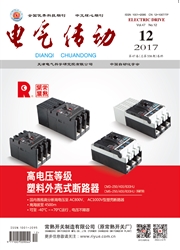

 中文摘要:
中文摘要:
在Saber中研究基于SiC JFET的矩阵变换器建模仿真。介绍了常通型SiC JFET相关参数的提取方法,在Saber中建立常通型SiC JFET的仿真模型。提出一种基于常通型SiC JFET的双向开关结构,可有效克服常通型SiC JFET在系统上电瞬间及辅助电源故障时易导致输入电源短路的缺点。基于所提出的双向开关结构,搭建了3×3矩阵变换器仿真模型,用MAST语言实现矩阵变换器的双空间矢量控制算法。考虑到常通型SiC JFET的开通和关断时间差异,优化4步换流策略,改善了输出波形质量。仿真结果验证了所建SiC JFET和矩阵变换器的仿真模型,以及优化4步换流策略的正确性和有效性。
 英文摘要:
英文摘要:
Modeling of SiC JFET-based matrix converter(MC)is explored in Saber. Firstly,method of parameter extraction and modeling of normally-on SiC JFETs was introduced. Then a new bidirectional switch structure was proposed,which could overcome the drawbacks of normally-on SiC JFETs that short circuits were prone to happen at the moment of powerup and under the condition of auxiliary power supply failure. Based on the proposed bidirectional switch structure,the main circuit of 3×3 matrix converter was built in Saber. Then,double space vector modulation of matrix converter was realized with the MAST language. Considering the time difference between turn-on and turn-off of normally-on SiC JFET,an optimized four-step commutation strategy was used,which improved the quality of output waveform. Finally,simulation results demonstrate the validity and reliability of the proposed model and optimized four-step commutation strategy.
 同期刊论文项目
同期刊论文项目
 同项目期刊论文
同项目期刊论文
 期刊信息
期刊信息
